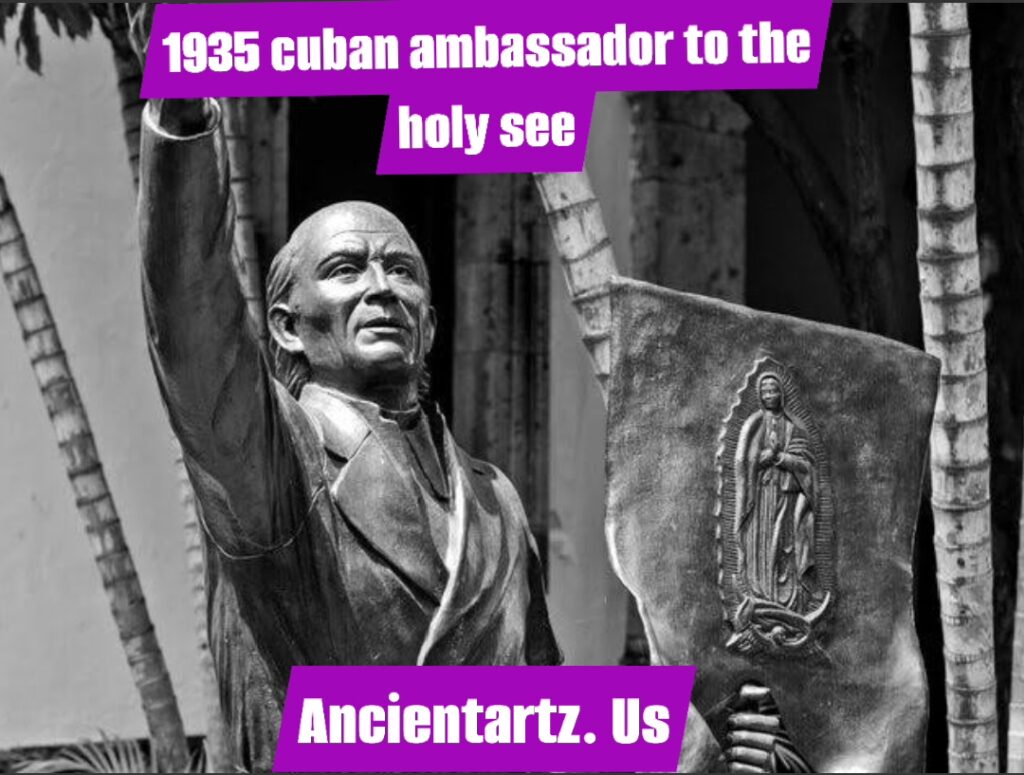Introduction
The year 1935 marked a significant chapter in the history of Cuba’s international relations, particularly in its diplomatic ties with the Holy See. This period was characterized by political transitions, cultural exchanges, and a reassertion of Cuba’s presence on the global stage. The appointment of a Cuban ambassador to the Vatican was not only a diplomatic gesture but also a profound acknowledgment of the shared cultural and religious ties between Cuba and the Catholic Church. This article delves deep into the historical context, implications, and legacy of the Cuban ambassador’s role to the Holy See during this pivotal year. From the sociopolitical climate in Cuba to the Vatican’s global influence, understanding the nuances of this relationship provides valuable insights into the complexities of international diplomacy.
Cuba in the early 20th century was undergoing a dynamic transformation. The nation’s political landscape was marked by the aftermath of the U.S. intervention, the Platt Amendment, and a burgeoning sense of national identity. Against this backdrop, the Catholic Church remained a cornerstone of societal values, education, and morality, influencing millions of Cubans. The decision to appoint an ambassador to the Vatican was not merely symbolic but a strategic move to solidify Cuba’s ties with the Holy See and reinforce its Catholic heritage. Meanwhile, the Vatican was navigating its role in a rapidly changing world, dealing with the rise of fascism, communism, and modernist ideologies. This article explores the interplay between these two entities, shedding light on the significance of the Cuban ambassador’s mission.
By examining the historical context, the objectives of Cuba’s diplomatic mission to the Holy See, and the legacy of this appointment, this article aims to offer a comprehensive understanding of an era that shaped both Cuba and the Vatican’s approach to international relations. Through detailed analysis, we explore how this unique diplomatic relationship reflected broader cultural, religious, and geopolitical trends of the 1930s.
Historical Context of Cuba’s Diplomatic Engagement with the Holy See
The Sociopolitical Landscape of Cuba in 1935
Cuba in 1935 was a nation grappling with the aftershocks of political upheaval and economic instability. The overthrow of President Gerardo Machado in 1933 and the subsequent rise of Fulgencio Batista marked a turbulent era. Batista’s government sought to stabilize the nation, navigating complex relationships with the United States and addressing internal social challenges. Amid this backdrop, the Catholic Church played a stabilizing role, providing spiritual guidance and fostering a sense of community among Cubans. The decision to strengthen ties with the Vatican reflected the government’s acknowledgment of the Church’s influence and its potential to unify a divided populace.
The Role of the Vatican in Global Politics
During the 1930s, the Vatican was asserting its moral and diplomatic influence on the global stage. Under the leadership of Pope Pius XI, the Holy See was actively engaging with nations to promote peace and address the challenges posed by totalitarian regimes. The Lateran Treaty of 1929, which established Vatican City as an independent state, had solidified the Pope’s temporal authority and enhanced the Vatican’s ability to engage in diplomatic affairs. The Cuban ambassador’s appointment was thus part of a broader trend of nations recognizing the Vatican as a key player in international relations.
Cuba’s Religious and Cultural Identity
Cuba’s strong Catholic heritage was a driving force behind its decision to establish formal diplomatic relations with the Holy See. The Catholic Church had been instrumental in shaping Cuban society, influencing education, healthcare, and social values. By sending an ambassador to the Vatican, Cuba sought to reaffirm its commitment to these shared values and strengthen its cultural identity on the global stage. This move also underscored the government’s recognition of the Church’s role as a mediator in times of social and political unrest.
Objectives and Achievements of the Cuban Ambassador to the Holy See
Strengthening Religious and Cultural Ties
The primary objective of the Cuban ambassador was to reinforce the deep-rooted religious and cultural connections between Cuba and the Vatican. This involved engaging in dialogue on matters of mutual interest, such as the promotion of religious education, support for Catholic charities, and the preservation of religious freedoms. The ambassador played a crucial role in fostering goodwill and mutual respect between the two entities, highlighting the importance of faith in shaping national and international policies.
Addressing Sociopolitical Challenges
The 1930s were marked by significant challenges, including the rise of secularism, political instability, and economic hardships. The Cuban ambassador’s mission included addressing these issues through collaboration with the Vatican. By seeking the Holy See’s guidance and support, Cuba aimed to navigate these challenges while upholding its Catholic values. This partnership also involved advocating for social justice, promoting ethical governance, and supporting initiatives that aligned with the Church’s teachings.
Enhancing Cuba’s Global Standing
The appointment of an ambassador to the Holy See was a strategic move to enhance Cuba’s international reputation. By aligning itself with the Vatican, Cuba sought to project an image of a nation committed to peace, morality, and cultural preservation. This diplomatic relationship also provided Cuba with a platform to engage in broader discussions on global issues, such as human rights, economic development, and the fight against totalitarianism.
Legacy of the Cuban Ambassador’s Role in 1935
Impact on Cuban Society
The ambassador’s efforts to strengthen ties with the Vatican had a lasting impact on Cuban society. By promoting religious education and social programs, the mission contributed to the preservation of Cuba’s Catholic identity and fostered a sense of unity among its people. The collaboration with the Vatican also inspired initiatives aimed at addressing poverty, improving healthcare, and supporting marginalized communities, reflecting the Church’s commitment to social justice.
Influence on Cuba-Vatican Relations
The 1935 appointment set the stage for a long-standing relationship between Cuba and the Holy See. It paved the way for future collaborations, including visits by Catholic leaders to Cuba and joint efforts to address global challenges. This diplomatic milestone underscored the enduring relevance of faith-based diplomacy in fostering mutual understanding and cooperation between nations.
Broader Implications for International Diplomacy
The Cuban ambassador’s role in 1935 highlighted the importance of cultural and religious diplomacy in international relations. By engaging with the Vatican, Cuba demonstrated how shared values and mutual respect can transcend political differences and foster meaningful partnerships. This approach continues to serve as a model for nations seeking to build bridges and promote peace in an increasingly interconnected world.
Conclusion
The appointment of the Cuban ambassador to the Holy See in 1935 was a pivotal moment in the history of Cuba’s international relations. It reflected the nation’s commitment to its Catholic heritage, its desire to address sociopolitical challenges, and its aspiration to enhance its global standing. Through this diplomatic mission, Cuba and the Vatican forged a partnership that not only strengthened their cultural and religious ties but also contributed to broader discussions on peace, justice, and human dignity.
As we reflect on this historical milestone, it becomes evident that the relationship between Cuba and the Holy See was more than a mere diplomatic endeavor. It was a testament to the power of shared values and mutual respect in shaping a better world. The legacy of the 1935 Cuban ambassador’s mission serves as a reminder of the enduring relevance of faith-based diplomacy in addressing the challenges of our time.
Frequently Asked Questions (FAQs)
What was the significance of the Cuban ambassador’s appointment to the Holy See in 1935?
The appointment underscored the importance of cultural and religious diplomacy in strengthening ties between Cuba and the Vatican. It reflected Cuba’s commitment to its Catholic heritage and its desire to engage with the Holy See on matters of mutual interest.
How did the Vatican influence Cuba during this period?
The Vatican played a crucial role in providing moral and spiritual guidance, promoting social justice, and addressing global challenges. Its collaboration with Cuba helped reinforce the nation’s Catholic values and supported initiatives aimed at improving education, healthcare, and social welfare.
What was the legacy of the 1935 diplomatic mission?
The mission laid the foundation for a long-standing relationship between Cuba and the Holy See. It inspired future collaborations and highlighted the importance of faith-based diplomacy in fostering mutual understanding and cooperation.
How did the sociopolitical climate in Cuba influence this diplomatic relationship?
Cuba’s political instability and economic challenges in the 1930s underscored the need for a stabilizing force. The Catholic Church’s influence provided a sense of unity and moral guidance, making the Vatican a valuable partner in addressing these issues.
What lessons can be learned from the 1935 Cuban ambassador’s role?
The ambassador’s mission demonstrates the power of shared values and mutual respect in building meaningful diplomatic relationships. It serves as a model for nations seeking to promote peace, justice, and cultural preservation through international collaboration.
Also Read This: The 1935 Cuban Ambassador to the Holy See: A Historical Perspective


